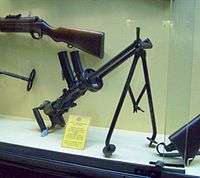Villar Perosa aircraft submachine gun
The Villar Perosa M15 was an Italian portable automatic firearm developed during World War I by the Officine di Villar Perosa.
| Villar Perosa | |
|---|---|
| Type | Submachine gun Aircraft machine gun |
| Place of origin | Italy |
| Service history | |
| Used by | See users |
| Wars | World War I |
| Production history | |
| Designed | 1914 |
| Specifications | |
| Mass | 6.5 kg (14 lb) |
| Length | 533 mm (21.0 in) |
| Barrel length | 320 mm (13 in) |
| Cartridge | 9mm Glisenti |
| Barrels | 2 side by side |
| Action | blowback |
| Rate of fire | 1200-1500 rounds/min per barrel, 2400-3000 total |
| Feed system | Box Magazine 25 rounds per gun |

Originally designed to be used by the second crew member/observer of military airplanes, it was later issued to ground troops. Between May and November 1916 a section was assigned to each infantry battalion of the Italian army and from May 1917 the number of sections was increased to 3 per battalion.
As it was designed to use 9mm pistol ammunition, it is said to be the first true submachine gun.[1]
Design
The Villar Perosa was designed as a portable double-barrel machine gun firing a 9mm round. It consisted of two independent coupled weapons, each with its own barrel, firing mechanism, and separate 25-round magazine.
As it was originally designed to be operated from airplanes, it had a high rate of fire of over 1,500 rounds per minute. However, in practice the 9mm munition was not sufficiently powerful to shoot down aircraft, which had become ever more resistant over the course of the war, and in addition the range was inadequate.
It was also used during World War I by the Italian infantry, with a bipod and a gun shield. Despite its high rate of fire, its atypical design, and its weight, it proved to be very effective at short range.[1]
Legacy
In 1918, the Austro-Hungarian Empire created a copy of the VP, the Sturmpistole M.18, which featured a straight magazine rather than curved magazines.[2]
The mechanism of the VP was a sound design, and shortly after the end of the war was used as the basis of a more practical weapon, the OVP 1918.
See also
Users
.svg.png)
.svg.png)
.svg.png)

See also
- Flieger-Doppelpistole 1919, Swiss equivalent.
- Gast gun
References
- Nicolle, David (25 Mar 2003). The Italian Army of World War I. Men-at-Arms 387. Osprey Publishing. p. 33. ISBN 9781841763989.
- Landships II, http://www.landships.info/landships/weapon_articles.html?load=weapon_articles/Villar_Perosa.html
- "Villar Perosa". Retrieved December 6, 2015.
- Anthony G. Williams (2012). Sub-Machine Gun: The Development of Sub-Machine Guns and their Ammunition from World War 1 to the Present Day. The Crowood Press UK. p. 260. ISBN 1847972934.
Bibliography
- George M. Chinn, The Machine Gun. History, Evolution, and Development of Manual, Automatic, and Airborne Repeating Weapons, Volume I.
- Philip Schreier, The World's First Sub-Gun. Guns & Ammo Surplus Firearms, September 2009.
External links
- YouTube video of the Villar Perosa SMG Firing
- Defence Configuration
- Replica Aircraft Configuration
- Villar Perosa 9mm MOD.15 SMG
- Modern Firearms
- VITTORIO BOBBA Pistola mitragliatrice Villar-Perosa mod. 1915 (in Italian)
- M1915 Video
- YouTube animation showing mechanism of Villar Perosa mounted in Voisin 3 aircraft